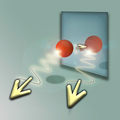Producing quantum-superpositions by simply using a mirror:
An atom and its quantum mirror image
05.04.2011, Press releases
Standing in front of a mirror, we can easily tell apart ourselves from our mirror image. The mirror does not affect our motion in any way. For quantum particles, this is much more complicated. In a spectacular experiment in the labs of the University of Heidelberg, a group of physicists from Heidelberg, Munich (TU and LMU) and TU Vienna extended a gedankenexperiment by Einstein and managed to blur the distinction between a particle and its mirror image. The results of this experiment have now been published in the journal “Nature Physics”.
When an atom emits light (i.e. a photon) into a particular direction, it recoils in the opposite direction. If the photon is measured, the motion of the atom is known, too. However, if a mirror is placed very closely to the atom, there are two possible paths for any photon travelling to the observer: it could have been emitted directly into the direction of the observer, or it could have travelled into the opposite direction and then been reflected in the mirror. If there is no way of distinguishing between these two scenarios, the motion of the atom is not determined.
A research team led by Mark K. Oberthaler, professor at the Kirchhoff Institute of Physics, University of Heidelberg, placed an excited atom only a few micrometers away from a gilded mirror and observed the state of the atom before and after the spontaneous emission of a single photon. If the photon is emitted perpendicular to the mirror an observer cannot distinguish whether the photon has first flown to the mirror and has been reflected or has been emitted directly into the direction of the observer, because of the fundamental limitations of quantum mechanics - temporal and spatial uncertainty. Quantum mechanically this is equivalent to a superposition of both states.
However, the atom receives a recoil from the emitted photon, and since it - figuratively speaking - can not distinguish in which direction the photon flew, the atom gets the rebound in two opposite directions. The atom thus moves simultaneously in two different directions - something beyond any imagination in the macroscopic world. But this particular state of the atom could be detected. If the emission of the photon parallel to the mirror, the various states are very well distinguished, and there is no superposition state.
“If the distance between the atom and the mirror is very small, it is physically impossible to distinguish between these two paths”, PhD student Jiri Tomkovic from Heidelberg explains. The particle and its mirror image cannot be clearly separated any more. The atom moves towards the mirror and away from the mirror at the same time. This may sound paradoxical and it is certainly impossible for macroscopic objects, but in quantum physics, this is a well-known phenomenon. “This uncertainty about the state of the atom does not mean that the measurement lacks precision”, professor Schmiedmayer (TU Vienna) emphasizes. “It is a fundamental property of quantum physics. The particle itself has not decided, in which of the two possible states it is.” The two states of the atom – moving towards the mirror and moving away from the mirror – are then combined on a grid made of laser light. That way it can be directly shown that the atom has indeed occupied both states at once.
This is reminiscent of the famous double-slit experiment, in which a particle hits a plate with two slits and passes through both slits simultaneously, due to its wave-like quantum mechanical properties. Einstein already discussed that this can only be possible if there is no way to determine which path the particle actually chose, not even precise measurements of any tiny recoil of the double slit plate itself. As soon as there is even a theoretically possible way of determining the path of the particle, the quantum superposition breaks down. “In our case, the photons play a role similar to the double slit”, professor Oberthaler (University of Heidelberg) explains. “If the light can, in principle, tell us about the motion of the atom, then the motion is unambiguously determined. Only when it is fundamentally undecidable, the atom can be in a superposition state, combining both possibilities.” And this fundamental undecidability is guaranteed by the mirror.
Probing under which conditions such quantum-superpositions can be created has become very important in quantum physics. “The fascinating thing about this experiment”, says researcher Martin Kiffner (TU Munich), “is the possibility of creating a quantum superposition state, using only a mirror, without any external fields.” In a very simple and natural way the distinction between the particle and its mirror image becomes blurred, without complicated operations carried out by the experimentator.
Original publication:
Single spontaneous photon as a coherent beamsplitter for an atomic matter-wave Jirí Tomkovic, Michael Schreiber, Joachim Welte, Martin Kiffner, Jörg Schmiedmayer and Markus K. Oberthaler Nature Physics, Advanced online publication, 3 April 2011, DOI: 10.1038/NPHYS1961
Kontakt: presse@tum.de
More Information
http://einrichtungen.physik.tu-muenchen.de/quantumdynamics/
| 110405_SinglePhoton_DE.pdf |
Druckversion der Presseinformation (DE),
(Type: application/x-pdf,
Size: 120.2 kB)
Save attachment
|
|
| 110307_PhotoCurrent_EN.pdf |
Printable version of the press release (EN),
(Type: application/x-pdf,
Size: 99.1 kB)
Save attachment
|




